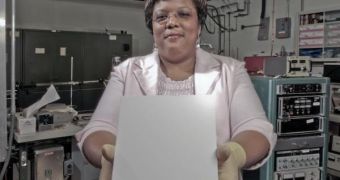Spacecraft are very prone to malfunctions caused by external influences. Things as small as bacteria can jeopardize an entire mission, especially if they form biofilms atop various gears, or inside astronauts' living quarters. In an attempt to ensure that this doesn't happen, experts at NASA again turned to nature for inspiration, and took after the beautiful lotus plant in creating a dust-busting, transparent coating, to apply on future space vehicles, ScienceDaily reports.
The coatings are developed by a joint partnership between the Linthicum, Maryland-based Northrop Grumman Electronics Systems, the NASA Goddard Space Flight Center, in Greenbelt, Maryland, and the Atlanta, Georgia-based nGimat Corporation. The transparent structure acts in a way similar to how the lotus plant sheds water, and experts believe that, once prototypes are completed, layers of coatings could potentially be used to keep microorganisms and dust away from vital spacecraft gears.
At first glance, a lotus leaf appears to be very smooth. But, when placed under the microscope, the surface reveals its amazing structure. Countless tiny spikes form on each square millimeter of the leaf, and drastically minimize the area where dust and water can grab a foothold. “If you splash lotus leaves with water, it just beads up and rolls off, indicating they have a special hydrophobic or water-repelling ability. This ability also prevents dust from adhering to the leaves,” the GSFC James Webb Space Telescope (JWST) Project Contamination and Coatings Lead, Eve Wooldridge, says.
The main active ingredients inside the chemicals that make up the coatings are silica, zinc oxide, and other types of oxides. The mix has tremendous properties back on Earth, on virtually any surface that needs to keep dust away. This includes everything from windshields to kitchen tables. But the two companies decided to pool their resources together with the GSFC, in order to take advantage of the extensive knowledge the NASA facility had on creating space-resistant structures.
“I think one of the most aggravating, restricting facets of lunar surface exploration is the dust and its adherence to everything no matter what kind of material, whether it be skin, suit material, metal, no matter what it be and its restrictive, friction-like action to everything it gets on,” Commander Eugene Cernan has said during the Apollo 17 Technical Crew Debriefing. “The coating as it was originally formulated will not be able to withstand the harsh environmental conditions found in space,” GSFC Coatings Engineering Group Lead Wanda Peters adds.
“We are modifying and testing the formula to ensure it can withstand all the challenges our hardware will encounter – extreme temperatures, ultraviolet radiation, solar wind, and electrostatic charging. Outgassing of the coating also must be addressed for use inside astronauts' habitation areas. We also are making sure it remains durable and cleanable in the space environment. We have a great team. Goddard is the only NASA center researching this type of coating, and we believe continued research will deliver great benefits to NASA's exploration missions and will produce many positive applications outside NASA,” she concludes.

 14 DAY TRIAL //
14 DAY TRIAL //